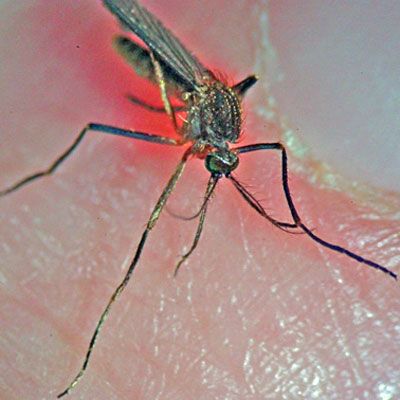What is Highlands J Virus?
Highlands J virus (HJ) is a mosquito-transmitted alphavirus that is similar to eastern equine encephalitis virus (EEE) in its natural cycle; it is transmitted from Culiseta melanura mosquitoes to songbirds in freshwater swamps. It has a low pathogenicity in mammals and is rarely seen in humans or horses. There have been outbreaks reported in penned birds, but the symptoms are mild compared to EEE.

Credit: C. Roxanne Connelly, UF/IFAS
Reports of Highlands J Virus in Animals
Reports of animals infected with HJ virus are not uncommon. Mortality in animals associated with an infection of HJ virus include domestic turkeys at a commercial facility and young broiler chickens in an experimental setting. In 1964, the cause of death of one horse in Florida was attributed to western equine encephalomyelitis virus (WEE). However, in 1989, researchers used new techniques to re-examine the virus that was isolated from the horse's brain. They identified the isolate to be a strain of HJ virus that is distinct from WEE.
Many animals have antibodies to HJ (are sero-positive for HJ) without any signs or symptoms of disease. This means that they were exposed to the virus, likely through the bite of an infected female mosquito, but there was no illness associated with the infection. Researchers in Florida reported antibodies to HJ in about 15% of the blue jays and scrub jays tested in Lake Placid, Florida, during 1994–95. In a sero-survey of small mammals in Indian River County, FL, one cotton mouse and one cotton rat had antibodies to HJ.
Mosquito Species Testing Positive for Highlands J Virus
Reports of mosquito species that have tested positive for HJ virus include Aedes cinereus, Aedes canadensis, Aedes cantator, Aedes vexans, Culex pipiens, Culiseta melanura, and Culiseta morsitans.
Is Highlands J Virus a problem for humans?
During the 1990–91 St. Louis encephalitis (SLE) outbreak in Florida, four patients were reported to be dually infected with SLE and HJ; however, exposure to HJ virus has not been directly associated with human illness.
Even though HJ virus is not a major pathogen for humans, it is always prudent to be aware of current conditions in any part of Florida where humans may be exposed to mosquito bites. HJ is present in Florida, and there will always be a small number of humans exposed to this virus. A rise in the number of humans infected with HJ would have to be considered a potentially dangerous situation due to the potential for HJ to cause more disease in people whose immune system has been weakened, i.e., the elderly and those who are immunocompromised.
References
Day, J. F., L. M. Stark, J. T. Zhang, A. M. Ramsey, and T. W. Scott. 1996. "Antibodies to arthropod-borne encephalitis viruses in small mammals from southern Florida." J. Wildl. Dis. 32:431–436.
Garvin, M. C., K. A. Tarvin, L. M. Stark, G. E. Wollfended, J. W. Fitzpatrick, and J. F. Day. 2004. "Arboviral infection in two species of wild jays (Aves: Corvidae): evidence for population impacts." J. Med. Entomol. 41:215–25.
Karabatsos, N., A. L. Lewis, C. H. Calisher, A. R. Hunt, and J. T. Roehrig. 1988. "Identification of Highlands J virus from a Florida horse." Am. J. Trop. Med. Hyg. 19:603–606.
Meehan, P. J., D. L. Wells, W. Paul, E. Buff, A. Lewis, D. Muth, R. Hopkins, N. Karabastos, and T. F. Tsai. 2000. "Epidemiological features of and public health response to a St. Louis encephalitis epidemic in Florida, 1990–91." Epidemiol. Infect. 125:181–188.